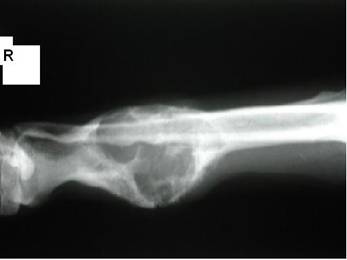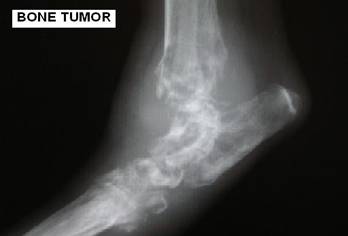

|
BONE CANCER
The most common type of bone cancer is Osteosarcoma. Osteosarcoma is a condition in which malignant cancer cells are found in the bone. It is the most common type of bone cancer. Children tend to commonly have this cancer occur in the bones around the knee. The most common occurrences of Osteosarcoma are in adolescents and young adults. Other types of bone cancer include malignant fibrous histiocytoma of the bone (a rare bone tumor) and Ewing ís sarcoma (different shaped cancer cells).
The chance of recovery or a patientís prognosis as well as the patientís choice of treatment depends on the size, location, type, and stage of the cancer. Other factors are how long the patient has had symptoms, how much of the cancer is taken out by surgery and/or killed by chemotherapy, and the patient's age, blood and other test results.
What Are Bone Metastases Cancerous growths can begin in any body organ or tissue. Wherever it begins, we call this site the primary tumor or primary cancer. We may also name it after the part of the body it affects. Thus cancer that grows in the breast first is called breast cancer.
After cancer has developed in one area of the body, cancerous cells from that area can break away and travel through the body's bloodstream or lymphatic system to other parts of the body. Most often these cells die, but sometimes they begin to grow and multiply. We call this process metastasis and any secondary growths metastases. About half of all cancers metastasize.
Wherever the secondary cancer is located on the body, the cancerous cells at the secondary site are like those at the primary site and the secondary cancer is named after the part of the body where the cancer first started. If, for example, prostate cancer spreads to the bones, the secondary cancer is metastasized prostate cancer, not bone cancer.
Cancer cells often spread first to lymph nodes near the primary tumor. Infection of these regional lymph nodes is called regional disease or nodal involvement. When cancer cells spread to areas of the body distant from the primary tumor, doctors call this metastatic disease. When the cancer cells spread to the bone, we call these areas bone metastases. The spine is the part of the skeleton most commonly affected by bone metastasis. The next most common sites are the pelvis, hip, upper leg bones (femurs), and the skull.
A patient's symptoms, physical examination, imaging tests, and blood tests may suggest that bone metastases are present. However, in most cases, this suspicion must be confirmed by examination of a tissue or cell sample under a microscope. Other diseases, such as bone infections can cause symptoms and imaging results that could be confused with bone metastases
Who Develops Bone Metastases
Any type of cancer can spread to the bone. But the most common metastasizing cancers are breast, lung, kidney, thyroid and prostate.
Symptoms of Bone Metastases
Pain in the bones is the main symptom of bone metastases. The pain may be worse at night at first, and may come and go. Later on the pain may become constant and may worsen when the patient is active.
Some patients with bone metastases experience relatively mild symptoms, such as decreased appetite and unusual sleep patterns due to discomfort. Others may notice frail or brittle bones, nausea, fatigue, muscle weakness, restlessness, and confusion.
Sometimes a primary cancer is discovered only after a metastasis causes symptoms. Many men with prostate cancer, for example, will show no symptoms until they start experiencing lower back pain caused by the metastasis of the prostate cancer into the bones in the back.
How Bone Metastases Cause Bone Weakening
The new tumors that develop in the bones can cause bone weakening in multiple ways. Three common sources of bone weakening caused by bone metastases are listed below:
Osteolytic lesions - are small holes in the bones. These holes form because the presence of cancerous cells cause the production of substances that activate bone-resorbing cells (osteoclasts) to increase. This increased activity of the osteoclasts results in bone loss without enough bone repair and growth. These holes in the bone make them very weak and brittle.
Osteosclerotic lesions - are abnormal bone formations that are stimulated by the cancerous cells. These new bone formations are generally very weak and unstable and can easily break.
Osteoblastic lesions - are bone growths induced by tumor growth factors, often more dense than surrounding bone tissue.
Diagnosing Bone Metastases
Metastatic cancers may be found at the same time as the primary tumor, or months or years later. When a second tumor is found in a patient who has been treated for cancer in the past, it is more often a metastasis than another primary tumor. In most cases, the primary cancer is found before bone metastases. In this case, doctors will perform a physical examination of the site, and may perform blood or imaging tests (such as X-rays) to get a thorough look at the primary tumor.
If a bone tumor is suspected, the doctor will do a complete medical examination, including a blood test as bone tumors are often associated with higher levels of certain proteins in the blood. After the blood test and examination, the doctor may ask for X-rays and other bone scans (such as a radionuclide bone scan, computed tomography, or magnetic resonance imaging) that can show areas of the bones with unusual changes. These can include unusually dark areas of bone, unusually white areas or what can look like small pockmarks or holes. A patient may also get blood tests to measure the presence of certain chemicals released by some types of cancer (such as prostate-specific antigen) or substances released by damaged parts of the body (such as the calcium released by damaged bones).
Next, if it still looks like the patient may have a bone tumor, a biopsy will be performed. The doctor will remove a tiny amount of tissue from the suspected area with a hollow needle. He or she will examine this tissue under a microscope to see if it is cancerous. Doctors also determine at this time if a bone tumor is a primary or secondary cancer. A primary bone tumor will have cancerous bone cells; a secondary bone tumor will contain cancer cells from another part of the body such as the breast or the leg.
In a small number of cancer patients, a secondary tumor is diagnosed, but no primary cancer is ever found. Doctors refer to the primary tumor as unknown or occult, and the patient is said to have cancer of unknown primary origin (CUP).
Patients with one type of cancer may develop a primary bone cancer at a later time, and treatment of a bone metastasis and a new primary bone cancer differ greatly. A diagnosis of bone metastasis has such a great impact on treatment options and prognosis that it is important to thoroughly exclude any other possibilities, such as a bone infection, benign bone tumor, or a primary bone cancer. In most cases, a biopsy is considered necessary to diagnose a patient's first bone metastasis, but additional bone metastases can usually be diagnosed based by x-rays and other imaging tests.
Treating Bone Metastases
Only a patient's own physician, who is familiar with his or her medical history, can decide the best path. Options generally include treatments that are palliative (which give relief from symptoms), or curative. Those with advanced, metastasized cancer may receive treatment focused on relieving pain and prolonging life. These treatments can include:
∑ Surgery to remove the original tumor and/or to remove parts of the body that produce hormones and other chemicals that aggravate cancer ∑ Radiation therapy (radiotherapy) ∑ Hormonal therapy Painkillers
In some cases doctors may feel curative treatments are in order for metastasized cancers. These treatments include chemotherapy, radiotherapy, hormone therapy, bone surgery and, more rarely, bone marrow or stem cell transplantation. |


|
BACK |







